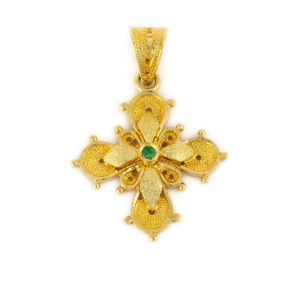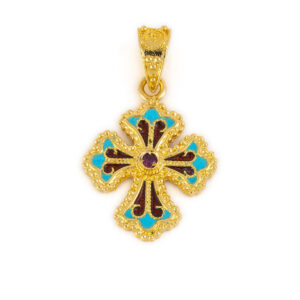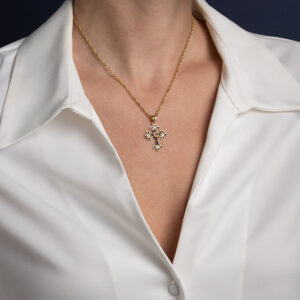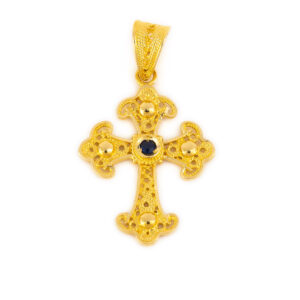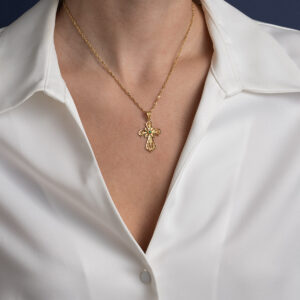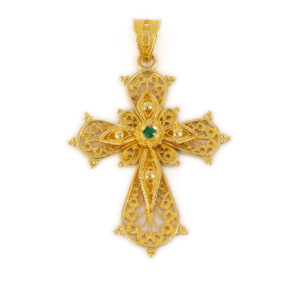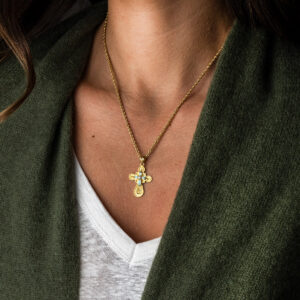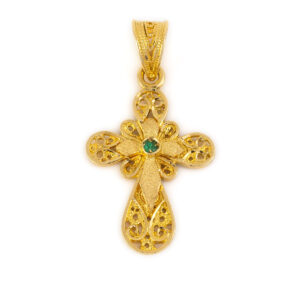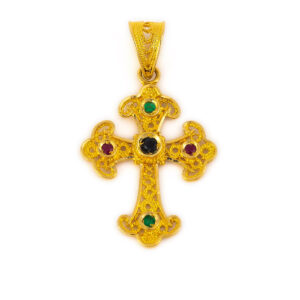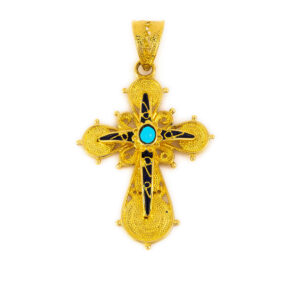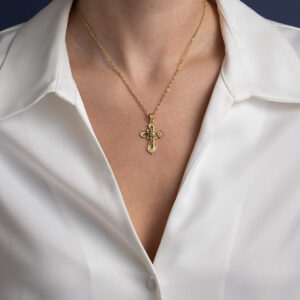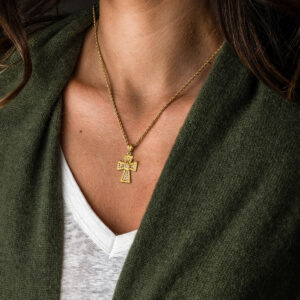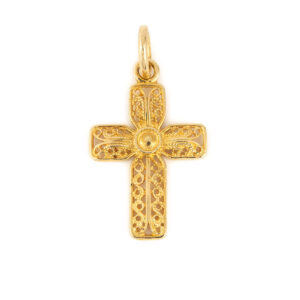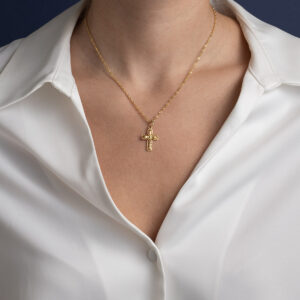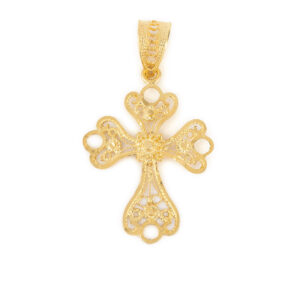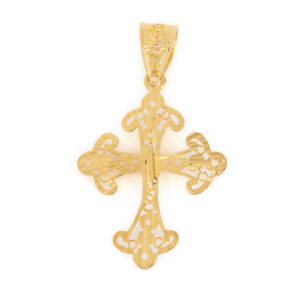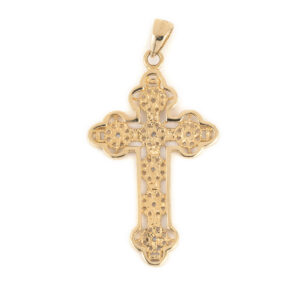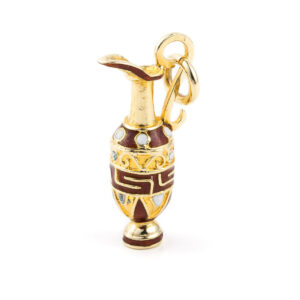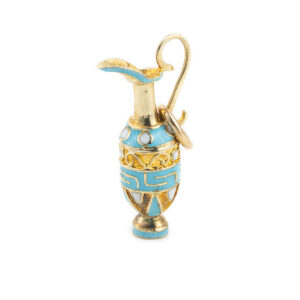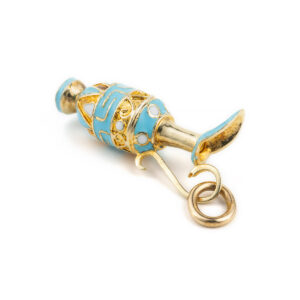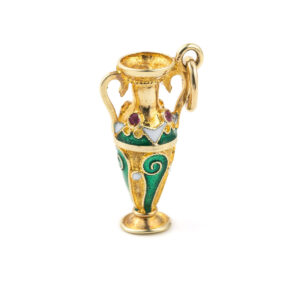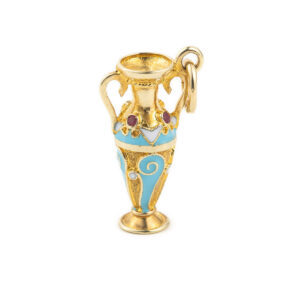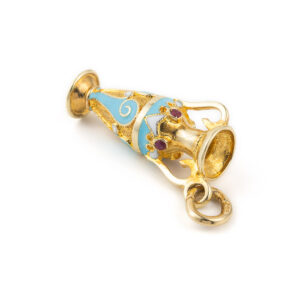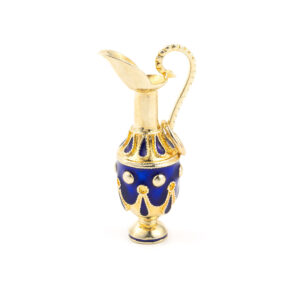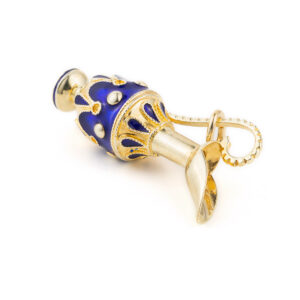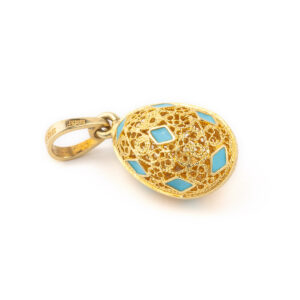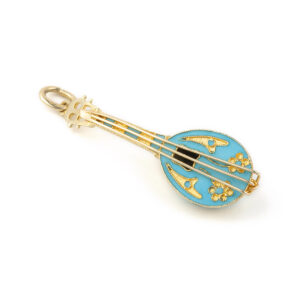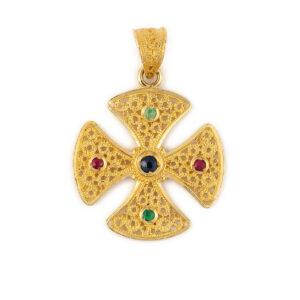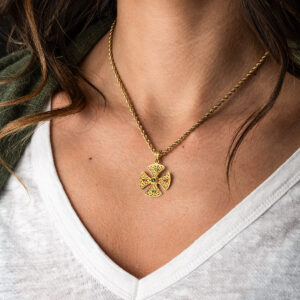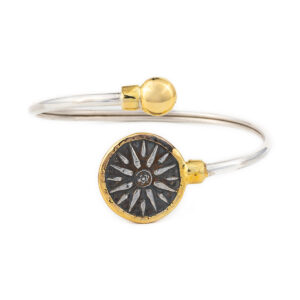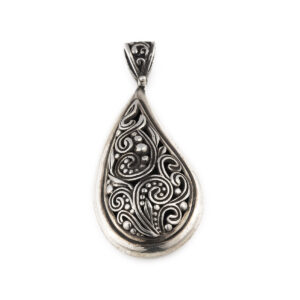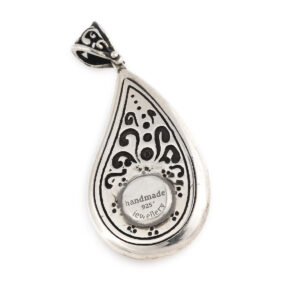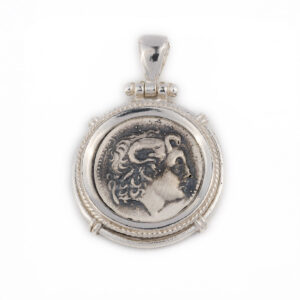18K Gold Byzantine Filigree Sapphire Cross
588,00€Byzantine Cross embellished with a fine filigree, a sapphire gemstone in the middle and granules of precious metal.
Handmade with great attention to detail. Inspired by Byzantine art.
Made in 18k gold
Filigree is a delicate kind of jewellery metalwork, made with tiny beads or twisted threads, or both in combination, soldered together or to the surface of an object of the same metal and arranged in artistic motifs. The art of filigree dates back to ancient history. The first of the found jewelry in this technique has been found in Mesopotamia and dates to thousands of years BC. In the ancient world and particularly in Asia Minor, this art grew at the highest level.
Granulation (from Latin: granum = “grain”) is a jewellery technique whereby a surface of a jewel is covered with small spheres or granules of precious metal. The technique is thought to have its origins in Mesopotamia about 5,000 years ago.
18K Gold Byzantine Filigree Emerald Cross
588,00€Byzantine Cross embellished with a fine filigree, an emerald gemstone in the middle and granules of precious metal.
Handmade with great attention to detail. Inspired by Byzantine art.
Made in 18k gold
Filigree is a delicate kind of jewellery metalwork, made with tiny beads or twisted threads, or both in combination, soldered together or to the surface of an object of the same metal and arranged in artistic motifs. The art of filigree dates back to ancient history. The first of the found jewelry in this technique has been found in Mesopotamia and dates to thousands of years BC. In the ancient world and particularly in Asia Minor, this art grew at the highest level. (*wikipedia)
Granulation (from Latin: granum = “grain”) is a jewellery technique whereby a surface of a jewel is covered with small spheres or granules of precious metal. The technique is thought to have its origins in Mesopotamia about 5,000 years ago.
18K Gold Byzantine Filigree Cross with Turquoise Enamel
738,00€Byzantine Cross embellished with a fine filigree, turquoise & red enamel and granules of precious metal.
The back side of the cross has no decoration.
Handmade with great attention to detail. Inspired by Byzantine art.
Made in 18k gold
Filigree is a delicate kind of jewellery metalwork, made with tiny beads or twisted threads, or both in combination, soldered together or to the surface of an object of the same metal and arranged in artistic motifs. The art of filigree dates back to ancient history. The first of the found jewelry in this technique has been found in Mesopotamia and dates to thousands of years BC. In the ancient world and particularly in Asia Minor, this art grew at the highest level.
Granulation (from Latin: granum = “grain”) is a jewellery technique whereby a surface of a jewel is covered with small spheres or granules of precious metal. The technique is thought to have its origins in Mesopotamia about 5,000 years ago.
As in all handmade items there may be small differences in weight and dimensions and this is what makes them unique and precious.
18K Gold and Blue Enamel Byzantine Ruby Cross
546,00€Byzantine Cross embellished with blue and white enamel, with a rosette flower in the center which is decorated with a ruby and granules of precious metal.
The back side of the cross has no decoration. Available with turquoise enamel. Choose your preferred enamel color.
Handmade with great attention to detail. Inspired by Byzantine art.
Made in 18k gold
Filigree is a delicate kind of jewellery metalwork, made with tiny beads or twisted threads, or both in combination, soldered together or to the surface of an object of the same metal and arranged in artistic motifs. The art of filigree dates back to ancient history. The first of the found jewelry in this technique has been found in Mesopotamia and dates to thousands of years BC. In the ancient world and particularly in Asia Minor, this art grew at the highest level.
Granulation (from Latin: granum = “grain”) is a jewellery technique whereby a surface of a jewel is covered with small spheres or granules of precious metal. The technique is thought to have its origins in Mesopotamia about 5,000 years ago.
Rosette flower
The rosette (rose) is a timeless jewel, symbol and amulet. The origin of the term is the Greek word for rose – rodon (ρόδον). Its use began in the Mycenaean era and continues as far as the 2nd millennia BC. The Mycenaean Rosette is a motif that was widespread throughout Mesopotamia, Egypt, Greece and other ancient civilizations. It is inspired by a Mycenaean rosette bead, found at Mycenae, dated to 1400-1300 B.C. The rosette was used extensively in ancient Greek Mycenaean jewels, in architecture, pottery and in sculptures from 1500 BC. Mycenaean rosettes usually had 6 or 8 or 12 leaves, and sixteen leaves during the Macedonian Dynasty. Such details as the rodax shape and the number of leaves tend to vary with the era or beliefs. The rosettes were used to decorate the cloths, belts and wreaths of the Kings. The number of leaves had a symbolic character each time. The four elements of nature (wind, earth, fire, water), the seven wonders of the ancient world or the twelve gods of ancient Greeks and the world domination and radiance of the Kings of Macedonia. They were signs of beauty, purity, eugenics, worship and power. Rosette or Rodax was probably the most popular and favorite decorative element in Mycenaean era, classical antiquity and Byzantine times.
As in all handmade items, there may be small differences in weight and dimensions and this is what makes them unique and precious.
18K Gold and Turquoise Enamel Byzantine Ruby Cross
546,00€Byzantine Cross embellished with turquoise and white enamel, and a rosette flower in the center which is decorated with a ruby and granules of precious metal.
The back side of the cross has no decoration. Available with green enamel. Choose your preferred enamel color.
Handmade with great attention to detail. Inspired by Byzantine art.
Made in 18k gold
Filigree is a delicate kind of jewellery metalwork, made with tiny beads or twisted threads, or both in combination, soldered together or to the surface of an object of the same metal and arranged in artistic motifs. The art of filigree dates back to ancient history. The first of the found jewelry in this technique has been found in Mesopotamia and dates to thousands of years BC. In the ancient world and particularly in Asia Minor, this art grew at the highest level.
Granulation (from Latin: granum = “grain”) is a jewellery technique whereby a surface of a jewel is covered with small spheres or granules of precious metal. The technique is thought to have its origins in Mesopotamia about 5,000 years ago.
Rosette flower
The rosette (rose) is a timeless jewel, symbol and amulet. The origin of the term is the Greek word for rose – rodon (ρόδον). Its use began in the Mycenaean era and continues as far as the 2nd millennia BC. The Mycenaean Rosette is a motif that was widespread throughout Mesopotamia, Egypt, Greece and other ancient civilizations. It is inspired by a Mycenaean rosette bead, found at Mycenae, dated to 1400-1300 B.C. The rosette was used extensively in ancient Greek Mycenaean jewels, in architecture, pottery and in sculptures from 1500 BC. Mycenaean rosettes usually had 6 or 8 or 12 leaves, and sixteen leaves during the Macedonian Dynasty. Such details as the rodax shape and the number of leaves tend to vary with the era or beliefs. The rosettes were used to decorate the cloths, belts and wreaths of the Kings. The number of leaves had a symbolic character each time. The four elements of nature (wind, earth, fire, water), the seven wonders of the ancient world or the twelve gods of ancient Greeks and the world domination and radiance of the Kings of Macedonia. They were signs of beauty, purity, eugenics, worship and power. Rosette or Rodax was probably the most popular and favorite decorative element in Mycenaean era, classical antiquity and Byzantine times.
Byzantine Filigree Ruby Cross in 18K Gold
798,00€Byzantine Cross embellished with fine filigree and a flower in the center which is decorated with a ruby
Handmade with great attention to detail. Inspired by Byzantine art.
Made in 18k gold
Filigree is a delicate kind of jewellery metalwork, made with tiny beads or twisted threads, or both in combination, soldered together or to the surface of an object of the same metal and arranged in artistic motifs. The art of filigree dates back to ancient history. The first of the found jewelry in this technique has been found in Mesopotamia and dates to thousands of years BC. In the ancient world and particularly in Asia Minor, this art grew at the highest level.
Filigree Sapphire Cross in 18K Gold
483,00€Byzantine Cross embellished with a fine filigree, a sapphire gemstone in the middle and granules of precious metal.
Handmade with great attention to detail. Inspired by Byzantine art.
Made in 18k gold
Filigree is a delicate kind of jewellery metalwork, made with tiny beads or twisted threads, or both in combination, soldered together or to the surface of an object of the same metal and arranged in artistic motifs. The art of filigree dates back to ancient history. The first of the found jewelry in this technique has been found in Mesopotamia and dates to thousands of years BC. In the ancient world and particularly in Asia Minor, this art grew at the highest level.
Granulation (from Latin: granum = “grain”) is a jewellery technique whereby a surface of a jewel is covered with small spheres or granules of precious metal. The technique is thought to have its origins in Mesopotamia about 5,000 years ago.
Byzantine Filigree Sapphire Cross in 18K Gold
546,00€Byzantine Cross embellished with a fine filigree and a sapphire gemstone in the middle.
Handmade with great attention to detail. Inspired by Byzantine art.
Made in 18k gold
Filigree is a delicate kind of jewellery metalwork, made with tiny beads or twisted threads, or both in combination, soldered together or to the surface of an object of the same metal and arranged in artistic motifs. The art of filigree dates back to ancient history. The first of the found jewelry in this technique has been found in Mesopotamia and dates to thousands of years BC. In the ancient world and particularly in Asia Minor, this art grew at the highest level.
18K Gold Filigree Cross with Emerald
546,00€Byzantine Cross embellished with a fine filigree, an emerald gemstone in the middle and granules of precious metal.
Handmade with great attention to detail. Inspired by Byzantine art.
Made in 18k gold
Filigree is a delicate kind of jewellery metalwork, made with tiny beads or twisted threads, or both in combination, soldered together or to the surface of an object of the same metal and arranged in artistic motifs. The art of filigree dates back to ancient history. The first of the found jewelry in this technique has been found in Mesopotamia and dates to thousands of years BC. In the ancient world and particularly in Asia Minor, this art grew at the highest level.
Granulation (from Latin: granum = “grain”) is a jewellery technique whereby a surface of a jewel is covered with small spheres or granules of precious metal. The technique is thought to have its origins in Mesopotamia about 5,000 years ago.
18K Gold Filigree Cross with Ruby
546,00€Byzantine Cross embellished with a fine filigree, a ruby gemstone in the middle and granules of precious metal.
Handmade with great attention to detail. Inspired by Byzantine art.
Made in 18k gold.
The chain shown is our 14K Gold Rope Chain (not included).
Filigree is a delicate kind of jewellery metalwork, made with tiny beads or twisted threads, or both in combination, soldered together or to the surface of an object of the same metal and arranged in artistic motifs. The art of filigree dates back to ancient history. The first of the found jewelry in this technique has been found in Mesopotamia and dates to thousands of years BC. In the ancient world and particularly in Asia Minor, this art grew at the highest level.
Granulation (from Latin: granum = “grain”) is a jewellery technique whereby a surface of a jewel is covered with small spheres or granules of precious metal. The technique is thought to have its origins in Mesopotamia about 5,000 years ago.
18K Gold Filigree Emerald Cross
1.012,00€Byzantine Cross embellished with a fine filigree, an emerald gemstone in the middle and granules of precious metal.
Handmade with great attention to detail. Inspired by Byzantine art.
Made in 18k gold
Filigree is a delicate kind of jewellery metalwork, made with tiny beads or twisted threads, or both in combination, soldered together or to the surface of an object of the same metal and arranged in artistic motifs. The art of filigree dates back to ancient history. The first of the found jewelry in this technique has been found in Mesopotamia and dates to thousands of years BC. In the ancient world and particularly in Asia Minor, this art grew at the highest level.
Granulation (from Latin: granum = “grain”) is a jewellery technique whereby a surface of a jewel is covered with small spheres or granules of precious metal. The technique is thought to have its origins in Mesopotamia about 5,000 years ago.
18K Gold Filigree Cross with Pearl
726,00€The cross is embellished with a fine filigree, turquoise enamel and pearl.
Inspired by Byzantine art.
Made in 18k gold
Handmade item.
The chain shown is our 14K Gold Rope Chain (not included).
Filigree is a delicate kind of jewellery metalwork, made with tiny beads or twisted threads, or both in combination, soldered together or to the surface of an object of the same metal and arranged in artistic motifs. The art of filigree dates back to ancient history. The first of the found jewelry in this technique has been found in Mesopotamia and dates to thousands of years BC. In the ancient world and particularly in Asia Minor, this art grew at the highest level.
18K Gold Emerald Filigree Cross
440,00€Byzantine Cross embellished with fine filigree and a sapphire or ruby or emerald gemstone in the middle.
Handmade with great attention to detail. Inspired by Byzantine art.
Made in 18k gold
Filigree is a delicate kind of jewellery metalwork, made with tiny beads or twisted threads, or both in combination, soldered together or to the surface of an object of the same metal and arranged in artistic motifs. The art of filigree dates back to ancient history. The first of the found jewelry in this technique has been found in Mesopotamia and dates to thousands of years BC. In the ancient world and particularly in Asia Minor, this art grew at the highest level..
Multi precious Cross in 18K Gold
506,00€Byzantine Cross decorated with rubies, emeralds and sapphires, granules of precious metal and fine filigree. Choose among emeralds, rubies, sapphires or multi-precious stones.
Inspired by Byzantine art.
Made in 18k gold
Handmade item.
The chain shown is our 14K Gold Rope Chain (not included).
Filigree is a delicate kind of jewellery metalwork, made with tiny beads or twisted threads, or both in combination, soldered together or to the surface of an object of the same metal and arranged in artistic motifs. The art of filigree dates back to ancient history. The first of the found jewelry in this technique has been found in Mesopotamia and dates to thousands of years BC. In the ancient world and particularly in Asia Minor, this art grew at the highest level.
18K Gold Filigree Cross with double enamel
672,00€Byzantine Cross embellished with fine filigree and double enamel
Handmade with great attention to detail. Inspired by Byzantine art.
Made in 18k gold
Filigree is a delicate kind of jewellery metalwork, made with tiny beads or twisted threads, or both in combination, soldered together or to the surface of an object of the same metal and arranged in artistic motifs. The art of filigree dates back to ancient history. The first of the found jewelry in this technique has been found in Mesopotamia and dates to thousands of years BC. In the ancient world and particularly in Asia Minor, this art grew at the highest level. (*wikipedia)
18K Gold Byzantine Cross with Swarovski
809,00€Byzantine Cross embellished with a fine filigree and great attention to detail. The decoration of this cross shows the influence of the Byzantine art.
Made in 18k gold.
Handmade item
The chain shown is our 14K Gold Rope Chain (not included).
Filigree is a delicate kind of jewellery metalwork, made with tiny beads or twisted threads, or both in combination, soldered together or to the surface of an object of the same metal and arranged in artistic motifs. The art of filigree dates back to ancient history. The first of the found jewelry in this technique has been found in Mesopotamia and dates to thousands of years BC. In the ancient world and particularly in Asia Minor, this art grew at the highest level.
Alexander The Great Ring – 14K Gold and Sterling Silver
242,00€Ring inspired by the Ancient Greek coin of Alexander the Great.
Made in 14k gold and 925 sterling silver.
Alexander the Great the King of Macedonia is considered one of the most important forms of world history.
Handmade item.
Byzantine Filigree Cross in 18K Gold
315,00€Byzantine Cross decorated with fine filigree.
Inspired by Byzantine art.
Made in 18k gold
Handmade item
Filigree is a delicate kind of jewellery metalwork, made with tiny beads or twisted threads, or both in combination, soldered together or to the surface of an object of the same metal and arranged in artistic motifs. The art of filigree dates back to ancient history. The first of the found jewelry in this technique has been found in Mesopotamia and dates to thousands of years BC. In the ancient world and particularly in Asia Minor, this art grew at the highest level.
Byzantine Filigree Cross in 14K Gold
238,00€Byzantine Filigree Cross in 14K Gold
Inspired by Byzantine art.
Made in 14k gold
Handmade item
Byzantine Cross in 14K Gold
256,00€Byzantine Cross
Inspired by Byzantine art.
Made in 14k gold
Handmade item
Byzantine Cross in 14K Gold
255,00€Byzantine Cross
Inspired by Byzantine art.
Made in 14k gold
Handmade item
14k Gold Pendant Amphora with Red enamel & Meander
492,00€Ancient Greek Amphora Pendant with red enamel and Meander design.
Design inspired by the ancient Greek history.
Made in 14k yellow gold
Also available with turquoise or blue enamel
Available in 3 sizes.
Handmade item.
The chain shown is our 14K Gold Chain (not included).
Amphora is a Greco – Roman word developed in ancient Greek during the Bronze Age. An amphora is a type of container of a characteristic shape and size. Amphorae were used for the transport and storage of various products, both liquid and dry, but mostly for wine. They are most often ceramic. the amphorae used in Ancient Greek vase painting. (source wikipedia)
Meander or Meandros design, one of the most historic symbols of the Greek World, also called Greek Key and symbolizes long life and eternity. The pattern with Meander was used in antiquity to decorate the frieze of temples.
14k Gold Pendant Amphora with Turquoise enamel & Meander
492,00€Ancient Greek Amphora Pendant with Turquoise enamel and Meander design.
Design inspired by the ancient Greek history.
Made in 14k yellow gold
Also available with red or blue enamel
Available in 3 sizes
Handmade item
Amphora is a Greco – Roman word developed in ancient Greek during the Bronze Age. An amphora is a type of container of a characteristic shape and size. Amphorae were used for the transport and storage of various products, both liquid and dry, but mostly for wine. They are most often ceramic. the amphorae used in Ancient Greek vase painting. (source wikipedia)
Meander or Meandros design, one of the most historic symbols of the Greek World, also called Greek Key and symbolizes long life and eternity. The pattern with Meander was used in antiquity to decorate the frieze of temples.
14k Gold Pendant Amphora with Green enamel
492,00€Ancient Greek Amphora Pendant with green enamel.
Design inspired by the ancient Greek history.
Made in 14k yellow gold
Also available with red or turquoise enamel
Handmade item
Amphora is a Greco – Roman word developed in ancient Greek during the Bronze Age. An amphora is a type of container of a characteristic shape and size. Amphorae were used for the transport and storage of various products, both liquid and dry, but mostly for wine. They are most often ceramic. the amphorae used in Ancient Greek vase painting. (source wikipedia)
14k Gold Pendant Amphora with Turquoise enamel
492,00€Ancient Greek Amphora Pendant with turquoise enamel.
Design inspired by the ancient Greek history.
Made in 14k yellow gold
Also available with red or green enamel
Handmade item
Amphora is a Greco – Roman word developed in ancient Greek during the Bronze Age. An amphora is a type of container of a characteristic shape and size. Amphorae were used for the transport and storage of various products, both liquid and dry, but mostly for wine. They are most often ceramic. the amphorae used in Ancient Greek vase painting.
14k Gold Pendant Amphora with Blue enamel
1.309,00€Ancient Greek Amphora Pendant with blue enamel.
Design inspired by the ancient Greek history.
Made in 14k yellow gold
Also available with turquoise or green enamel
Handmade item
Amphora is a Greco – Roman word developed in ancient Greek during the Bronze Age. An amphora is a type of container of a characteristic shape and size. Amphorae were used for the transport and storage of various products, both liquid and dry, but mostly for wine. They are most often ceramic. the amphorae used in Ancient Greek vase painting. (source wikipedia)
14k Gold Filigree Egg Pendant with Turquoise enamel
476,00€The pendant is embellished with fine filigree and turquoise enamel in Faberge style. Also, the pendant is decorated with a floral design.
Used as a charm or as a pendant.
Pick up a beautiful gift inspired by the majestic art of Fabergé!
Made in 14k yellow gold.
The chain shown is our Cable Chain in 14K Gold (not included).
Filigree is a delicate kind of jewelry metalwork, made with tiny beads or twisted threads, or both in combination, soldered together or to the surface of an object of the same metal and arranged in artistic motifs. The art of filigree dates back to ancient history. The first of the found jewelry in this technique has been found in Mesopotamia and dates to thousands of years BC. In the ancient world, particularly in Asia Minor, this art grew at the highest level.
Fabergé egg is a jeweled egg created by the House of Fabergé, in St. Petersburg, Imperial Russia. Virtually all were manufactured under the supervision of Peter Carl Fabergé between 1885 and 1917,[citation needed] the most famous being the 50 “Imperial” eggs, 43 of which survive, made for the Russian Tsars Alexander III and Nicholas II as Easter gifts for their wives and mothers. The first Fabergé egg was crafted for Tsar Alexander III, who had decided to give his wife, Empress Maria Feodorovna, an Easter egg in 1885. Peter Carl Fabergé was a Russian jeweler best known for the famous Fabergé eggs made in the style of genuine Easter eggs, using precious metals and gemstones. He’s the founder of the famous jewelry legacy House of Fabergé. (Wikipedia)
14k Yellow Gold Greek Bouzouki Charm with Turquoise Enamel
730,00€Greek Bouzouki Charm with turquoise enamel decorated with rosette motifs.
Made in 14k yellow gold.
Used as a charm or as a pendant.
Handmade in Greece.
Design inspired by the Greek tradition.
Explore Heritage Collection
History
The Greek bouzouki is a plucked musical instrument of the lute family, called the thabouras or tambouras family. The tambouras existed in ancient Greece as the pandura, and can be found in various sizes and shapes. The bouzouki and the baglamas are the direct descendants. The bouzouki arrived in Greece following the 1919–1922 war in Asia Minor and the subsequent population exchange between Greece and Turkey. The early bouzoukia mostly had three courses. At the end of the 1950s, four-course (tetrachordo) bouzoukia started to gain popularity. The four-course bouzouki was made popular by Manolis Chiotis. Manolis Chiotis was a Greek rebetiko and laiko composer, singer, and bouzouki player. He is considered one of the greatest bouzouki soloists of all time.
Byzantine Cross in 18K Gold with rubies emeralds and sapphires
814,00€Byzantine Cross with rubies, emeralds and sapphires
Inspired by Byzantine art.
Made in 18k yellow gold
Handmade item.
The chain shown is our 14K Gold Rope Chain (not included).
As in all handmade items, there may be small differences in weight and dimensions and this is what makes them unique and precious.
Vergina Star Hinge Bracelet
376,00€Bracelets inspired by the ancient Vergina sun symbol.
Made in 925°sterling silver and 14K gold.
Handmade in Greece.
History
The Vergina Sun also known as the “Star of Vergina”, “Macedonian Star” is a rayed solar symbol appearing in ancient Greek art. The Vergina Sun proper has sixteen triangular rays. The name “Vergina Sun” became widely used after the archaeological excavations in and around the small town of Vergina, in northern Greece, during the late 1970s. In older references, the name “Argead Star” or “Star of the Argeadai” is used for the Sun as the royal symbol of the dynasty of Macedon. There it was depicted on a golden larnax found in a 4th-century BC royal tomb belonging to either Philip II or Philip III of Macedon, the father and half-brother of Alexander the Great, respectively.
Byzantine Filigree Drop Silver Pendant – Yianni Jewelry
This beautiful pendant represents the Byzantine design and ancient floral symbol.
Black oxidized background.
Made in 925° sterling silver.
Handmade Item.
Silver creations of Yianni Jewelry, created by Garbis Khacherian, a silversmith trader since 1987.
Alexander the Great & Lysimachus Coin Pendant
Ancient Greek coin representing Alexander the Great on one side and King Lysimachus on the other. Alexander the Great the King of Macedonia is considered one of the most important forms of world history. Lysimachus was a Macedonian officer and diadochus of Alexander the Great, who became a basileus in 306 BC, ruling Thrace, Asia Minor and Macedon.
Made in 925⁰ sterling silver.
Black oxidized background.
Handmade item.



